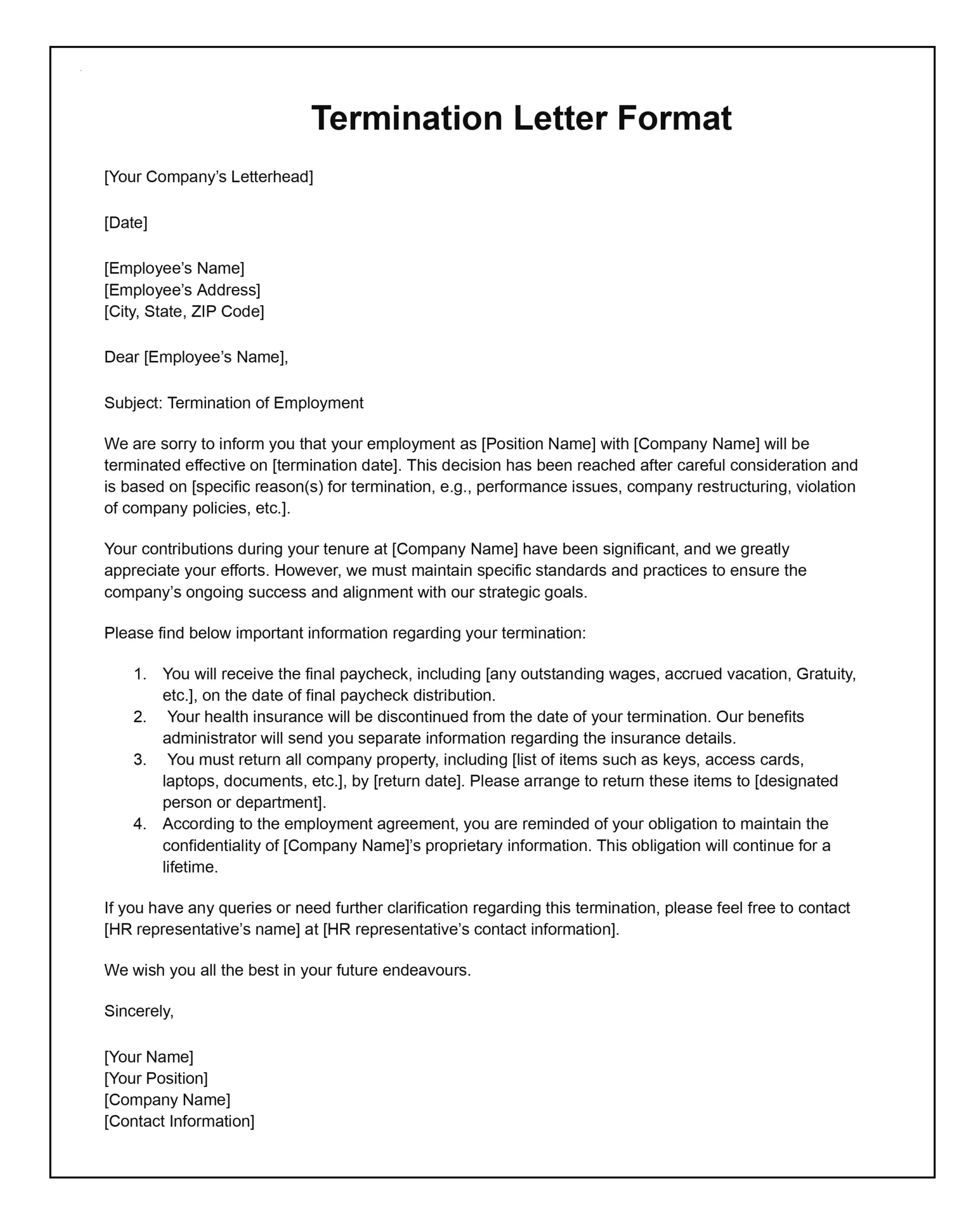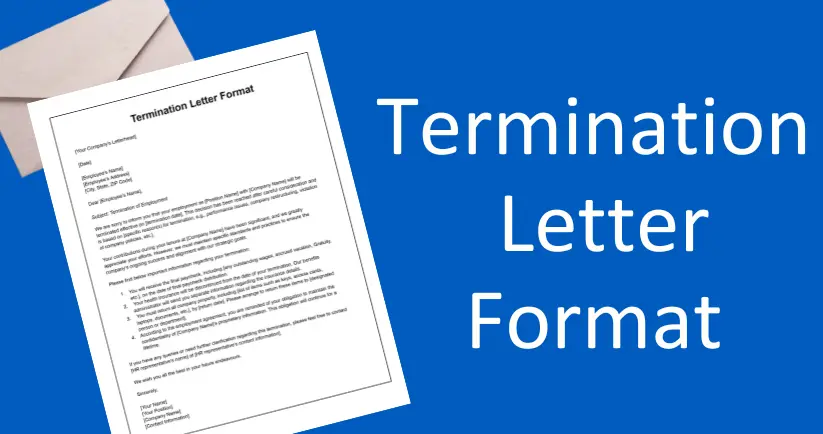Serving termination letters to employees is one of the most challenging tasks for employers. Employers often terminate employees for their poor performance, misconduct, or fraudulent activity. Whatever the reason behind the termination, strategising is essential. Employers usually send emails informing their employment is being terminated by mentioning the reason behind the termination.
Hence, maintaining a decent reputation, showing professionalism, and following the law and compliance against full and final settlement are essential for maintaining the company’s reputation. So, we will discuss the process of writing a termination letter properly in this blog. You’ll also find a few sample termination letters ready to be tailored to your requirements.
What is Termination Letter?
An employee termination letter is an official document that conveys the termination of an employee. The letter concludes with the reason for termination and other relevant details like the termination due date, final pay, FNF procedure, other benefits, and essential information.
A standard termination letter will have:
- The last day of the employment contract
- Reason for termination
- Details of Final Pay and Benefits
- Acknowledgment of Company Policies
- Closure and well wishes
Termination Letter Format in Word
We are sharing a termination letter sample for your reference, as it will cover all the required points essential for a termination letter. Feel free to edit it according to your company’s requirements.

Top 7 Termination Letter Format
Here are the top 7 types of termination letter format templates that can be useful for writing termination for your employees.
1. Termination Letter Format Due to Poor Performance
[Your Company Letterhead]
Termination Letter
[Employee Name]
[Employee Address]
[City, State, Zip Code]
[Date]
Dear [Employee Name],
I am sorry to inform you that your employment with [Company Name] is being terminated effective [termination date]. This decision is based on our assessment of your performance, including [specific issues or concerns].
We have provided you with feedback and opportunities for improvement over the past [time], but unfortunately, we have not seen the necessary progress. As a result, we have made the difficult decision to end your employment with the company.
Please be advised that your final paycheck, including any accrued vacation or PTO, will be processed and sent to you according to our standard payroll schedule. Additionally, please return any company property, including [list of items], before your departure date.
We wish you all the best in your future endeavours.
Sincerely,
[Your Name]
[Your Title]
[Company Name]
2. Termination Letter Format Due to Layoff or Workforce Reduction
[Your Company Letterhead]
Termination Letter
[Employee Name]
[Employee Address]
[City, State, Zip Code]
[Date]
Dear [Employee Name],
I regret to inform you that your position at [Company Name] is being eliminated as part of a workforce reduction initiative. Your last day of employment will be [termination date].
This decision does not reflect your performance or contributions to the company but rather results from [reason for the layoff, such as economic downturn, restructuring, or organizational changes].
Please be assured that we will provide you with [severance package details, outplacement services, or other support] to assist you during this transition period. Additionally, your final paycheck, including any accrued vacation or PTO, will be processed and sent to you according to our standard payroll schedule.
We sincerely appreciate your work in [Company Name] and wish you all the best in your future endeavours.
Sincerely,
[Your Name]
[Your Title]
[Company Name]
3. Termination Letter Due to Resignation
[Your Company Letterhead]
Termination Letter
[Employee Name]
[Employee Address]
[City, State, Zip Code]
[Date]
Dear [Employee Name],
I am writing to confirm receipt of your resignation letter dated [resignation date]. As per your request, your employment with [Company Name] will be ended by the termination date] effectively.
We would like to take this opportunity to express our appreciation for your contributions to the company during your tenure. We understand and respect your decision to move on to new opportunities and wish you the best in your future endeavours.
Please let us know if there are any outstanding tasks or responsibilities that need to be addressed before your departure date. Your final paycheck, including any accrued vacation or PTO, will be processed and sent to you according to our standard payroll schedule.
Thank you again for your service to [Company Name]. We hope to maintain a positive relationship with you in the future.
Sincerely,
[Your Name]
[Your Title]
[Company Name]
4. Termination Letter Due to Misconduct
[Your Company Letterhead]
Termination Letter
[Employee Name]
[Employee Address]
[City, State, Zip Code]
[Date]
Dear [Employee Name],
I am writing to notify you that your employment with [Company Name] is being ended immediately due to [specific misconduct or violation of company policies].
Your actions have violated our company’s code of conduct and standards of behaviour, and despite previous warnings and opportunities for improvement, we cannot tolerate such behaviour in our workplace.
Please be advised that your final paycheck, including any accrued vacation or PTO, will be processed and sent to you according to our standard payroll schedule. Additionally, It will be a pleasure if you return any company property, including [list of items], immediately.
We wish you all the best in your future endeavours.
Sincerely,
[Your Name]
[Your Title]
[Company Name]
5. Contract Termination Letter
[Your Company Letterhead]
Termination Letter
[Employee Name]
[Employee Address]
[City, State, Zip Code]
[Date]
Dear [Employee Name],
I regret to inform you that your contract with [Company Name] will be ending on [termination date], as specified in our agreement dated [contract start date].
We would like to take this opportunity to thank you for your contributions to the company during the term of your contract. Your professionalism and dedication have been greatly appreciated.
Please let us know if there are any outstanding tasks or responsibilities that need to be addressed before your departure date. Your final paycheck, including any accrued compensation, will be processed and sent to you according to our standard payment terms.
We wish you all the best in your future endeavours and hope to have the opportunity to work with you again.
Sincerely,
[Your Name]
[Your Title]
[Company Name]
6. Termination Letter Due to Position Elimination
[Your Company Letterhead]
Termination Letter
[Employee Name]
[Employee Address]
[City, State, Zip Code]
[Date]
Dear [Employee Name],
I feel sorry to inform you that your position at [Company Name] is being eliminated effective [termination date]. This decision is part of a strategic restructuring initiative aimed at streamlining our operations and reallocating resources to better align with our business objectives.
While the decision is tough, please be informed that it does not reflect your performance or contributions to the company. Your professionalism and dedication have been greatly appreciated during your tenure with us.
As a result of the position elimination, your termination of employment letter with the company [Company Name] will be concluded, and your final paycheck, including any accrued vacation or PTO, will be processed and sent to you according to our standard payroll schedule.
We understand that this news may be unsettling, and we are committed to supporting you during this transition period. Please feel free to reach out to HR if you have any questions or need assistance with the next steps.
We are grateful for your service to [Company Name] and wish you all the best in your future endeavours.
Sincerely,
[Your Name]
[Your Title]
[Company Name]
7. Termination Letter Due to Company Closure
[Your Company Letterhead]
Termination Letter
[Employee Name]
[Employee Address]
[City, State, Zip Code]
[Date]
Dear [Employee Name],
I am writing to notify you that [Company Name] will be ceasing its operations effective [termination date]. This decision is due to [reason for closure, such as financial difficulties, market conditions, or unforeseen circumstances].
As a result of the company closure, your employment with [Company Name] will be terminated, and your final paycheck, including any accrued vacation or PTO, will be processed and sent to you according to our standard payroll schedule.
We understand that this news may come as a shock, and we deeply regret any inconvenience this may cause you. Please know that this decision was made after careful consideration of all available options, and it is not a reflection of your performance or dedication.
We would like to express our sincere gratitude for your contributions to [Company Name] during your time with us. Your hard work and commitment have been invaluable, and we wish you the best of luck in your future endeavours.
If you have any questions or need assistance during this transition period, please do not hesitate to contact HR.
Sincerely,
[Your Name]
[Your Title]
[Company Name]
What to Write in the Termination Letter?
While drafting a termination letter, employers often face trouble thinking about what would be within the letter that provides correct information regarding termination to the employee without violating any company rules and regulations.
In this section, we have piled up some points that must be included in the termination letter.
Let’s have a look at what a termination letter includes:
- Employee Name and Position
- Last Date of Employment
- Reason for Termination
- Final Paycheck Details
- Cessation of Benefits
- Asset Recovery Details
- Retirement fund transfer detail
How to Write a Termination Letter?
Errors in writing termination letters or misplacing attachments can lead to unnecessary harassment that reflects on the company’s reputation. Before initiating the termination process from the ESS portal, it is essential to pile up all the documents and employee-related details.
Here are the steps of how to write a termination letter.
Step1: Identify the Employee
In step 1, you need to write the employee’s name and identification number at the top of the email. Mentioning the name clarifies the person to whom you address the termination.
Step 2: Use a Soft but Professional Tone
During initiating the email, you can keep your writing tone smooth but professional. In this scenario, using ‘Dear’ is perfectly fine.
Step 3: Compose the body of email
Now, it is time to compose content. In case of termination, the writing style should be direct but gentle. Your approach should clarify the purpose and reason for the termination. You can mention the other employee-related details like paycheck details, Final Pay and Benefits details here. Or you can attach those details in the document as well.
Step 4: Engaging Signature Line
Closing the email cordially will engage the recipient. You can add respectful or kind regards along with the name and title of the human resources director or business owner. This will make your mail professional and more engaging.
Step 5: Prepare a Copy for Employee’s Signature
After completion of termination mail drafting, making another copy before sending is essential to safeguard employers against harassment or mistreatment.
Why Do You Use a Termination Letter
A termination letter is written proof of the employee’s discontinuation from the post. It includes the employee’s name and position, last date of employment, the reason for termination, final paycheck details, cessation of benefits, and other pertinent details.
Here are the top 6 reasons for using termination letters at the time of employment closure of any employees.
1. Documentation
Organizations can maintain documentation with a written record of termination that includes the reasons for termination, effective dates, and other details. It helps the employers as proof against any potential legal disputes or claims of unethical termination.
2. Clarity
Employers inform the employees about their end of employment by processing a termination letter. It ensures a clear understanding of the decision-making process and its implications regarding employee termination. Transparent paperwork through mail eliminates uncertainty and prevents misunderstanding about the termination, final pay, benefits, etc.
3. Compliance
Employers can tell about compliances like company policies, employment contracts, and legal requirements through processing termination letters. Termination letters communicate essential information about the termination process, such as the return of company property, continuation of benefits, and any post-termination obligations.
4. Professionalism
Mailing a termination letter to inform employees about the closure of their employment demonstrates professionalism and respect for the departing employee.
5. Legal Protection
A well-drafted termination letter helps employers avoid legal risks related to company policies, compliances, and other related employment laws. For future uses, a termination letter serves as evidence of maintaining a transparent relationship with the employees since the last day of employment.
6. Closure and Transition
During the closure of employment, processing a termination letter provides respect and maintains a balance in the employee-employer relationship within the company. It helps them understand the next steps, such as returning company property, applying for employment benefits, or seeking new employment opportunities.
Tips to Write a Termination Letter
Here are the following tips before writing a termination letter:
1. Maintain Professionalism
Maintaining professionalism is crucial throughout the termination process. Professional behaviour upholds the dignity and respect of the terminated employee. Using professionalism, employers can communicate without emotional bias. It eliminates misunderstandings or escalation.
Additionally, maintaining professionalism promotes a constructive and respectful termination process.
2. Gather Necessary Details
Before initiating a termination letter, it is essential to collect all necessary employee details, such as the employee handbook or policies, final pay and benefits information, and performance records.
Piling up the necessary details helps employers prepare proof against potential legal disputes or claims of unethical termination.
3. Mention the Termination Date
During the termination letter processing, it is mandatory to notify the joining and closing dates of employee employment to maintain clarity and certainty for both the employer and the employee.
Moreover, specifying the date in the termination letter helps employers comply with company policies, employment contracts, or applicable employment laws.
4. State a Reason for Termination
While writing a termination, a brief explanation of the reason(s) for termination helps both the employees and the employers maintain clarity and transparency during the Full and Final settlement.
Moreover, the reason provided should be factual and specific, avoiding personal opinions or judgments.
5. Explain Compensation and Benefits
Explaining compensation and benefits is one of the key elements to discuss during the termination letter processing. At the end of employment, the employee still receives benefits like final pay, accrued vacation, insurance, retirement benefits, and severance pay based on various factors like company policies, employment contracts, and applicable laws.
Discussing compensation and benefits briefly during proceeding termination mail ensures transparency, fairness, and compliance with legal requirements, contributing to a smoother transition for both the employer and the departing employee.
6. Confirms Employee Details
A company sometimes needs an employee contract after he leaves to send severance checks, tax documentation, or similar correspondence via mail.
Moreover, it is also part of the entire termination process, making a list of relevant contracts, such as cell phone, home address, etc., for future needs.
Significance of the Termination Letter
The following reasons state the importance of a termination letter:
- It is a tool used by employers to justify the termination of an employee. It makes it easier for the employee to know the claims and makes it difficult for the employer to modify their narrative.
- It serves as a former notice from the employer’s side and highlights their professionalism.
- It also acts as legal proof for any future references.
- It also helps in ending the relationship with an employee in an amicable manner.
- It gives the employee a fair amount of time and compensation to handle their unemployment situation.
Closure
Crafting a termination letter is a delicate task that requires empathy, clarity, and professionalism. It serves as a formal communication tool to make decisions with respect and dignity while providing necessary information and the next steps to the departing employee.
By adhering to best practices and legal guidelines, organizations can effectively navigate the termination process, uphold their reputation, and maintain positive relationships with departing employees and remaining staff. Handling terminations with sensitivity and professionalism contributes to a more respectful and supportive workplace culture.
FAQs on Termination Letter Format
1. Is termination the same as firing?
Termination and firing are not the same things; though they are somewhat interchangeable, there are some differences between them,
- Termination is when employees end their employment with a company. It can be voluntary, where employees resign by their choice, or involuntary, where employers end the relationship with employees.
- Conversely, firing is mainly considered an involuntary termination where employers end their relationship with employees due to performance issues, misconduct, or another employee’s fault.
2. Can an employee be terminated without notice?
As per the labour law of India, a company can’t terminate any employee immediately without any valid reason. They must provide the employees with a minimum of 30 days of notice. However, if employees commit misconduct, breach of contract, or redundancy, then the company is allowed to fire the employee immediately without any compensation or notice.
3. Do organizations need an employee termination form?
Yes, a company must maintain proper documentation of the termination process, including the notice period details, payment of use, exit form, and related correspondence, and share it with the employees during offboarding. The documentation can be helpful in case of any legal disputes and claims.
4. Can I use a termination letter sample to write my termination letter?
Yes, you can use any termination letter sample while writing. Numerous termination letter templates are available on our page. You can follow them all as required.
5. What should be included in a termination letter or email?
Points that should be included in a termination letter or an email are:
- Employee Name and Position
- Last Date of Employment
- Clear Reason for Termination
- Final Paycheck Details
- Cessation of Benefits
- Asset Recovery Details
- Retirement fund transfer detail
6. Does a Termination affect your career?
It depends on the reason behind the termination. The reason for ending your present job and related circumstances surrounding the job loss is between you and your employers only. It won’t hamper your future career.
But if you are getting fired, then it can be a bit traumatic, as the reason behind your job loss can affect your future career development.
7. Is it better to resign or get terminated?
If you are warned that you may be terminated, it is better to submit a resignation letter rather than experience the termination process.
8. Can I join the same company after termination?
Yes, As per the labour law, a former employee has the legal right to rejoin for the same position or a different position at the same company by accepting the following conditions,
- If you have not been fired previously,
- If you have the relieving letter from the company
- If there is a vacancy for the required position,
- If your prior company accepted the old employees,
- If you agree with the performance evolution process.









